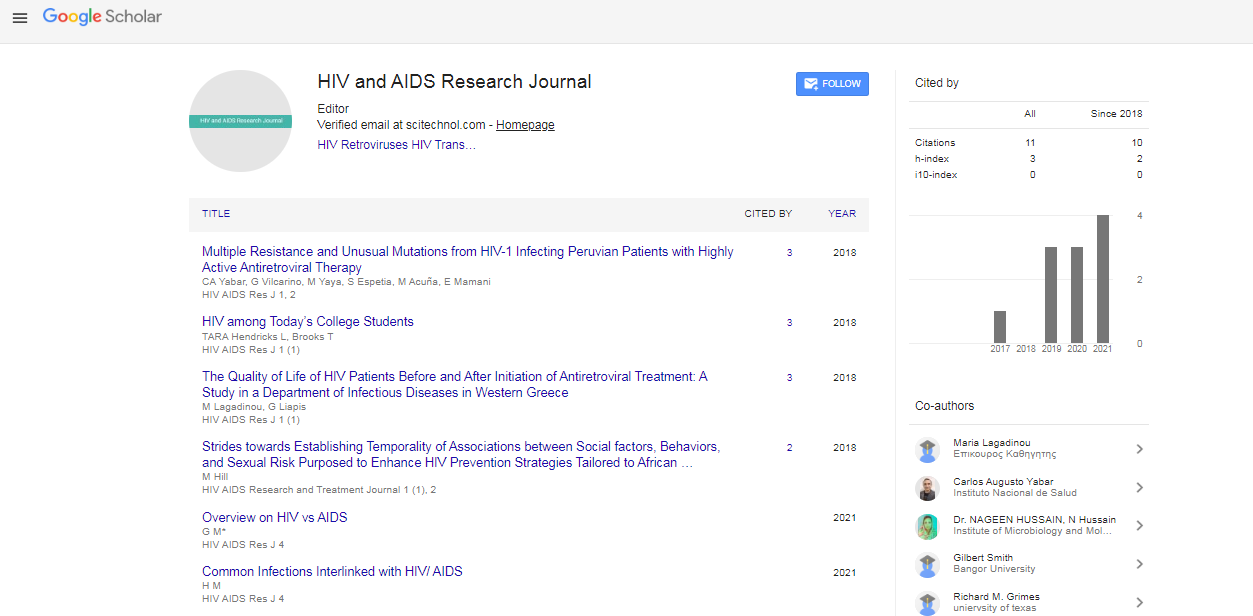Perspective, Hiv Aids Res J Vol: 6 Issue: 2
AIDS Pathogenesis: Mechanisms and Implications for Treatment
Jane Meliner*
1Department of Clinical Microbiology, Hadassah Hebrew University Medical Center, Jerusalem, Israel
*Corresponding Author: Jane Meliner,
Department of Clinical Microbiology,
Hadassah Hebrew University Medical Center, Jerusalem, Israel
E-mail: jane_meliner@hhumc22.il
Received date: 23 August, 2023, Manuscript No. HARJ-23-118049;
Editor assigned date: 25 August, 2023, PreQC No. HARJ-23-118049 (PQ);
Reviewed date: 08 September, 2023, QC No. HARJ-23-118049;
Revised date: 15 September, 2023, Manuscript No. HARJ-23-118049 (R);
Published date: 22 September, 2023, DOI: 10.4172/Harj.1000129
Citation: Meliner J (2023) AIDS Pathogenesis: Mechanisms and Implications for Treatment. HIV AIDS Res J 6:2.
Description
Acquired Immunodeficiency Syndrome, better known as AIDS, remains a significant global health challenge. Understanding the pathogenesis of AIDS and the processes by which Human Immunodeficiency Virus (HIV) leads to immune system destruction is essential in the development of effective treatment strategies. AIDS is the final stage of HIV infection, but the pathogenesis of the disease begins long before the clinical manifestation of immunodeficiency. To comprehend this process, it is important to understand the stages of HIV infection.
Acute infection is the initial phase following HIV exposure. The virus rapidly replicates within the body and establishes a systemic infection. During this stage, individuals may experience flu-like symptoms, but the virus often goes undiagnosed. After the acute phase, the virus enters a chronic or latent stage. It remains asymptomatic but continues to replicate. This phase can last for several years. Over time, the immune system weakens, leading to a symptomatic phase. Individuals may experience recurrent infections, weight loss, and fatigue. This stage is often referred to as AIDS, or Acquired Immunodeficiency Syndrome.
The pathogenesis of AIDS involves a complex interplay of mechanisms that HIV employs to undermine the immune system. CD4+ T cells are an essential component of the immune system, coordinating the body's response to infections. HIV specifically targets and infects CD4+ T cells, leading to their depletion. As the virus replicates, it destroys these immune cells, leaving the individual increasingly susceptible to infections.
HIV's ability to replicate quickly and mutate frequently is a hallmark of its pathogenesis. This high mutation rate allows the virus to evade the immune system and develop resistance to antiretroviral drugs. Chronic HIV infection results in persistent immune activation and inflammation. This state of chronic immune activation contributes to the damage to lymphoid tissue, where CD4+ T cells are primarily located.
Gut-Associated Lymphoid Tissue (GALT) HIV significantly affects the GALT, which plays an important role in the immune system. Damage to GALT is believed to be a key factor in the systemic immune dysfunction seen in AIDS. People with AIDS are more susceptible to a variety of opportunistic infections and cancers, including tuberculosis, pneumocystis pneumonia, and Kaposi's sarcoma, as their immune systems weaken.
Implications for treatment
Understanding the mechanisms of AIDS pathogenesis is essential for the development of effective treatment strategies. Here are some implications for the treatment of HIV and AIDS. Antiretroviral Therapy (ART) is the cornerstone of HIV treatment. It works by inhibiting viral replication and reducing the viral load in the body. Early initiation of ART during the chronic phase of infection can effectively slow down the progression to AIDS.
ART can lead to immune reconstitution, allowing the immune system to recover and rebuild CD4+ T-cell counts. This helps individuals living with HIV better manage infections and maintain their health. Understanding the pathogenesis of AIDS underscores the importance of preventive measures, such as consistent condom use and Pre-Exposure Prophylaxis (PrEP) to prevent transmission. Ongoing studies explore immune-modulating therapies to reduce immune activation and the inflammation associated with chronic HIV infection.
Conclusion
AIDS pathogenesis is a multifaceted process that involves the depletion of CD4+ T cells, viral replication, immune activation, and the emergence of opportunistic infections. Understanding these mechanisms is essential for developing effective treatment strategies. Antiretroviral therapy has transformed the landscape of HIV management, significantly improving the health and longevity of individuals living with the virus. Ongoing studies continue to unravel the complexities of AIDS pathogenesis, providing hope for the development of a cure and preventive measures. With this understanding, one can move closer to a world where AIDS is a manageable and ultimately preventable condition.
 Spanish
Spanish  Chinese
Chinese  Russian
Russian  German
German  French
French  Japanese
Japanese  Portuguese
Portuguese  Hindi
Hindi 